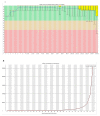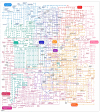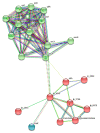Functional Annotation of Lactiplantibacillus plantarum 13-3 as a Potential Starter Probiotic Involved in the Food Safety of Fermented Products
- PMID: 36080167
- PMCID: PMC9458025
- DOI: 10.3390/molecules27175399
Functional Annotation of Lactiplantibacillus plantarum 13-3 as a Potential Starter Probiotic Involved in the Food Safety of Fermented Products
Abstract
The important role of Lactiplantibacillus plantarum strains in improving the human mucosal and systemic immunity, preventing non-steroidal anti-provocative drug-induced reduction in T-regulatory cells, and as probiotic starter cultures in food processing has motivated in-depth molecular and genomic research of these strains. The current study, building on this research concept, reveals the importance of Lactiplantibacillus plantarum 13-3 as a potential probiotic and bacteriocin-producing strain that helps in improving the condition of the human digestive system and thus enhances the immunity of the living beings via various extracellular proteins and exopolysaccharides. We have assessed the stability and quality of the L. plantarum 13-3 genome through de novo assembly and annotation through FAST-QC and RAST, respectively. The probiotic-producing components, secondary metabolites, phage prediction sites, pathogenicity and carbohydrate-producing enzymes in the genome of L. plantarum 13-3 have also been analyzed computationally. This study reveals that L. plantarum 13-3 is nonpathogenic with 218 subsystems and 32,918 qualities and five classes of sugars with several important functions. Two phage hit sites have been identified in the strain. Cyclic lactone autoinducer, terpenes, T3PKS, and RiPP-like gene clusters have also been identified in the strain evidencing its role in food processing. Combined, the non-pathogenicity and the food-processing ability of this strain have rendered this strain industrially important. The subsystem and qualities characterization provides a starting point to investigate the strain's healthcare-related applications as well.
Keywords: Lactiplantibacillus plantarum 13-3; food safety; functional annotation; probiotic; starter culture; whole genome.
Conflict of interest statement
The authors declare no conflict of interest.
Figures











References
MeSH terms
Substances
Grants and funding
LinkOut - more resources
Full Text Sources

